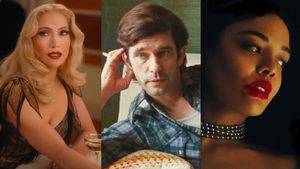
Treatment GuideJust DiagnosedSex & DatingAfrican AmericanStigmaAsk the HIV DocPrEP En EspañolNewsVoicesPrint IssueVideoOut 100
CONTACTCAREER OPPORTUNITIESADVERTISE WITH USPRIVACY POLICYPRIVACY PREFERENCESTERMS OF USELEGAL NOTICE
© 2025 Pride Publishing Inc.
All Rights reserved
All Rights reserved
By continuing to use our site, you agree to our Privacy Policy and Terms of Use.
In this era of highly active antiretroviral therapy we don't expect to see much HIV-related wasting. In fact, most HIV--specialist clinicians are likely to see more obesity than wasting these days. But if you think wasting is purely a historical phenomenon, think again. In the case of symptomatic HIV infection the percentage of wasting remains about the same, defining about 20% of U.S. AIDS cases in the HAART era. Thus, as the number of newly defined AIDS cases declines, the total number of wasting--driven AIDS definitions has declined as well. However, wasting is not something to start ignoring. It is still the most deadly form of malnutrition. Weight loss and losses in the body's protein stores are strong predictors of survival with chronic HIV infection.
The new face of wasting is somewhat different. In 2002 researchers suggested that while there may be fewer cases of severe weight loss, some patients experience a slow and insidious loss of lean tissue that can put them at higher risk for poor health outcomes. Their study found that loss of 10% or more of ideal weight'which defines AIDS wasting syndrome'was uncommon; it was seen in only 2% of the 172 HIV--infected men in the study. But more than one third of those men had lost a significant amount of lean tissue, and over 12% had lost more than 5% of their lean tissue over a period of eight months. The strongest risk factor for this loss was an elevation in cytokine levels. The body is quite efficient in providing its own source of protection by breaking down muscle tissue to produce cytokines, which are minuscule proteins that help the body mount protective responses to infection, including against HIV. Cytokines can cause the body to use up more calories per day while at the same time depressing appetite. This works well during short-term infections when cytokines help the body concentrate on ridding itself of unwanted infectious invaders. However, in long--term or chronic infections, such as with HIV disease, elevated levels of cytokines can pose a continuing challenge.
Though this study suggested that elevated levels of cytokines were most strongly associated with lean muscle--tissue wasting, calorie balance and hormonal normality are also important factors in preserving lean muscle tissue. Hypogonadism and calorie deficits related to a loss of appetite or nutrient malabsorption have been implicated in the disappearance of muscle mass. As muscle mass declines, the body can reduce energy output to spare as much of its tissues as possible, putting muscle tissue into a stagnant state of disuse. Unfortunately, this is a classic case of losing what you don't use. Each player in the very complex mystery of muscle decline is important to both the prevention and the treatment of muscle wasting.
For instance, if you take in an adequate amount of calories but still have high levels of cytokines and low levels of anabolic hormones (or resistance to the hormones), it is unlikely that you will be able to restore your lost muscle tissue to its former state.
Likewise, you are less likely to benefit from hormone replacement therapy if you don't have an adequate calorie intake and don't regularly stimulate your muscles. With adequate calorie intake, resistance exercise, and treatment for changes in the levels or effectiveness of the body's anabolic hormones, it is likely the body will respond well to maintaining its balance of lean tissues.But what about the cytokine challenge? It is a bit trickier to deal with. If cytokines are blocked (by aspirin, for instance) to prevent a loss of lean tissues, the body may not adequately protect itself by producing cytokines to turn on the immune system when it is needed.
There have been several recommendations for anticytokine therapy, pretty much none of which is a common treatment. Many factors can play a significant role in keeping cytokines in check'regular exercise, an improved diet with foods low in saturated fats and high in quality proteins and sources of omega--3 fatty acids found in fish and flaxseed, smoking cessation, reduction of alcohol abuse, and other lifestyle changes. Controlling high viral loads and low immune-cell counts are of course important too. Once again, balance and moderation may be the key factors in building a foundation for living well with chronic HIV infection.
Fields-Gardner is the director of services for the HIV nutrition company Cutting Edge and is a member of the International AIDS Society and the American Dietetic Association's Dietetic Practice Group on HIV and AIDS.
From our Sponsors
Most Popular
“So much life to live”: Eric Nieves on thriving with HIV
September 03 2025 11:37 AM
The Talk: Beyond the exam room
August 13 2025 3:15 PM
Thanks to U=U, HIV-positive people can live long, happy, healthy lives
July 25 2025 2:37 PM
BREAKING: Supreme Court rules to save free access to preventive care, including PrEP
June 27 2025 10:32 AM
Messenger RNA could be the key to an HIV vaccine — but government cuts pose a threat
August 20 2025 8:02 AM
“I felt like a butterfly”: Niko Flowers on reclaiming life with HIV
July 23 2025 12:22 PM
Dancer. Healer. Survivor. DéShaun Armbrister is all of the above
July 02 2025 8:23 PM
The Talk: Starting the conversation
July 25 2025 4:47 PM
The lab coat just got queer
August 21 2025 10:00 AM
Plus: Featured Video
Latest Stories
HIV-positive men stage 'Kiss-In' protest at U.S.-Mexico border
December 01 2025 12:56 PM
What the AIDS crisis stole from Black gay men
December 01 2025 6:00 AM
Amazing People of 2025: Javier Muñoz
October 17 2025 7:35 PM
It’s National PrEP Day! Learn the latest about HIV prevention
October 10 2025 9:00 AM
“I am the steward of my ship”: John Gibson rewrites his HIV narrative
September 16 2025 2:56 PM
The Talk: Owning your voice
August 25 2025 8:16 PM
The Talk: Navigating your treatment
August 01 2025 6:02 PM
How the Black AIDS Institute continues to fill in the gaps
July 25 2025 1:06 PM
1985: the year the AIDS crisis finally broke through the silence
June 26 2025 11:24 AM
VIDEO: A man living with HIV discusses his journey to fatherhood
June 10 2025 4:58 PM
Trump admin guts $258 million in funding for HIV vaccine research
June 03 2025 3:47 PM
Grindr is reminding us why jockstraps are so sexy and iconic
May 02 2025 5:36 PM
HRC holds 'die-in' to protest Trump health care cuts
April 28 2025 2:11 PM
Two right-wing Supreme Court justices signal they may uphold access to PrEP and more
April 21 2025 4:10 PM
500,000 Children at Risk: PEPFAR Funding Crisis
April 08 2025 3:51 PM
Broadway's best raise over $1 million for LGBTQ+ and HIV causes
April 03 2025 7:15 PM
The Talk Season 5 premieres this spring with HIV guidance for the newly diagnosed
March 26 2025 1:00 PM







































































